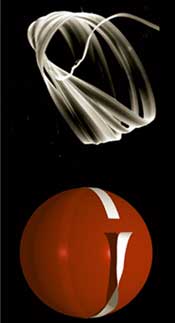Scientists Create Crystal Möbius Strip

Image: Courtesy of Taku Tsuneta and Syujiro Mori
A signature of arts and crafts sessions, the Möbius strip–a seemingly endless ribbon with only one side and one edge that can be made from construction paper and sticky tape–has been given a new look. According to a report published today in the journal Nature, scientists have succeeded in growing crystals in the form of Möbius structures.
A piece of ribbon or paper can be twisted and turned easily, so a regular Möbius strip itself is no great feat of engineering. Crystals, in contrast, contain an inherently rigid structure. To manufacture their miniature Möbius strips, Satoshi Tanda of Hokkaido University in Japan and his colleagues placed a mixture of selenium (Se) and niobium (Nb) powder in a quartz tube and heated it to temperatures greater than 700 degrees Celsius. Under these conditions, Se changes among vapor, mist and liquid phases. The tiny drops of liquid selenium acted as spools on which the strips formed (see image). As the crystals of NbSe3 grew, they wrapped around the droplet and the two ends met, making a seamless ring the diameter of a human hair. By changing the growing conditions, the researchers coaxed the crystals into twisting either once, resulting in a Möbius strip, or twice, which created a “figure-of-eight” crystal strip.
Exactly what these mini Möbius strips could be used for is unclear. But the scientists suggest that strips of different sizes could be manufactured by varying the size of the liquid drops, and they have already applied their technique to a number of other compounds. The authors propose that these strangely shaped crystals could aid studies of the quantum mechanical effects of surface features.
Media Contact
All latest news from the category: Life Sciences and Chemistry
Articles and reports from the Life Sciences and chemistry area deal with applied and basic research into modern biology, chemistry and human medicine.
Valuable information can be found on a range of life sciences fields including bacteriology, biochemistry, bionics, bioinformatics, biophysics, biotechnology, genetics, geobotany, human biology, marine biology, microbiology, molecular biology, cellular biology, zoology, bioinorganic chemistry, microchemistry and environmental chemistry.
Newest articles

Zap Energy achieves 37-million-degree temperatures in a compact device
New publication reports record electron temperatures for a small-scale, sheared-flow-stabilized Z-pinch fusion device. In the nine decades since humans first produced fusion reactions, only a few fusion technologies have demonstrated…

Innovative microscopy demystifies metabolism of Alzheimer’s
Researchers at UC San Diego have deployed state-of-the art imaging techniques to discover the metabolism driving Alzheimer’s disease; results suggest new treatment strategies. Alzheimer’s disease causes significant problems with memory,…

A cause of immunodeficiency identified
After stroke and heart attack: Every year, between 250,000 and 300,000 people in Germany suffer from a stroke or heart attack. These patients suffer immune disturbances and are very frequently…





















